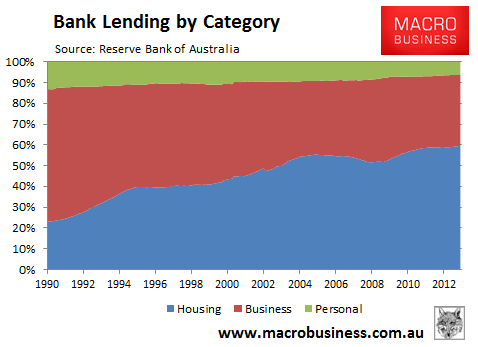
The emerging debate about bank funding is heating up. The big splash by the Australian Centre for Financial Studies and its Funding the Future project has set things off but NAB wades in today:
A senior National Australia Bank executive says global requirements to hold more capital mean banks may not have the funds needed to lend to companies if there is a pick-up in demand for credit.
…“There is a concern the banks have got that with the new regulatory regime they are facing, when credit demand again picks up in the economy, the traditional way of funding Australian corporates we think is under threat,” Mr Lambert said. “The traditional way is for the banks to fund them. Right at the moment, credit growth has not been that strong so for many corporates, it is not a real problem because they don’t have to raise any money at the moment and if they did, the banks are still there. That is all true and I don’t think that this a problem today. This is about what could be in the future…If the banks are gong to have potential constraints, then who could potentially step in to fill the void?,” Mr Lambert said.
His answer is a domestic corporate bond market, which makes a certain amount of sense.
However, it also raises an interesting question about the future for banks. 60% of bank lending is already aimed at mortgages – a share that has more than doubled since 1990 at the expense of business lending (see below chart). If we’re going to shift corporate funding into a bond market then banks are going to become gigantic building societies with capital market functions tacked on.

Is this an answer to Australia’s slow motion current account squeeze? Already concentrated risk will grow and so too, therefore, will public support for the banks.
It seems to me we are putting the cart before the horse here. The assertion that the banks have a funding shortfall owing to the siphoning off of superannuation savings is a subset of a larger and more important macroeconomic question. Why is the sum total of Australian saving and investment still in deficit during a terms of trade boom?
So long as we run this current account deficit, you can juggle the allocation of Australian savings all you like but someone still has to either borrow offshore or sell assets to foreigners or you’re still in a funding squeeze. Tipping super savings into a local bond market pulls the funds out of somewhere else and only shifts the pressure.
To me it’s plainly obvious why we run this current account deficit. We over-invest in unproductive assets via banks that have an excessive rate of return based upon over-leveraged mortgage lending. Given offshore bank borrowing is tapped out and the mining boom that was funded by retained earnings is ending, the only other realistic option to sustain the system is externally-funded public deficits. I can support that to the extent that it adds to productivity and helps close the funding gap longer term.
But any bank reform we conduct should do nothing to prevent Basel III from crimping bank returns and bringing greater stability to our financial system as well as freeing it from public support. If that means lower bank returns and asset prices so be it. That’ll help us compete with the world in the real economy, as well as correct the funding squeeze for the banks and nation over time.

